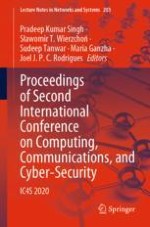2021 | Buch
Proceedings of Second International Conference on Computing, Communications, and Cyber-Security
IC4S 2020
herausgegeben von: Dr. Pradeep Kumar Singh, Prof. Dr. Sławomir T. Wierzchoń, Sudeep Tanwar, Dr. Maria Ganzha, Prof. Joel J. P. C. Rodrigues
Verlag: Springer Singapore
Buchreihe : Lecture Notes in Networks and Systems
